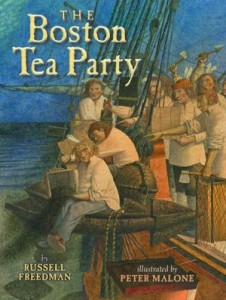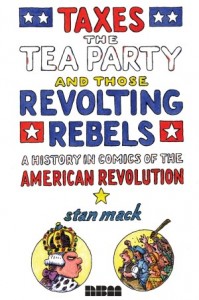Two hundred and thirty-nine years ago this month, a band of New England Patriots (not the NFL team) disguised as Indians swarmed aboard three ships in the harbor and dumped a cargo of tea. It wasn’t the shot heard ’round the world, but the line from Boston Harbor to Lexington is pretty straight. A good book on the subject was published a few months ago, and while we’re at it, we can look at some more recent books on the days of ’76.
The Boston Tea Party, by Russell Freedman, illustrated by Peter Malone. Holiday House, 2012, 39 pages. 

Ever since the publication of Abraham Lincoln: a Photobiography, in 1986 (one of the rare nonfiction Newbery Medal winners) Russell Freedman has been a reliable name in American history for children. Most of his titles are best classified as chapter books, with copious illustration. The Boston Tea Party is a true picture book, though it says something when a picture book includes an index! One thing it says is that the information herein has been thoroughly researched and the events described have historical significance. That’s why I put the lower age level at 7, when kids are just beginning to get a true sense of the past. As pure story, aside from history, it still makes compelling reading.
The author’s introduction gives us a background of rising tensions between Great Britain and her American colonies. We forget that other tea ships docked in New York, Philadelphia, and Charleston, where the colonists either turned the ships away or refused to distribute the cargo. Massachusetts Royal Governor Thomas Hutchinson, however, was determined to take a stand for the crown and ordered the tea to be brought ashore. Sam Adams’ Sons of Liberty plotted a dramatic protest, triggered by a huge gathering in Old South Church on Dec. 16, 1773. After a final request to the Governor was refused, Sam Adams mounted t0 the pulpit and shouted, “This meeting can do nothing more to save the country!” Apparently it was a signal (though the author is careful not to say so for sure, since nobody knows)—war whoops came from the back of the church balcony and men rushed home to paint their faces and wrap themselves in blankets.
Using first-person accounts, many of them from teenagers, Russell puts together the story of an organized protest (not a “mob,” as the British later claimed), who accomplished their purpose in full view of the town, injured no one, spoke respectfully to ships’ officers, and filed peaceably home when the job was done. To this day, no one knows their identity, except for family stories that were passed down—like the merchant who shook the loose tea out of his boots when he got home, swept it up and kept it in a bottle which would be treasured as an heirloom.
The Boston “Tea Party” provoked a series of British reprisals leading directly to the six-year conflict that gave birth to a nation. Though high-spirited, it was not rowdy, hysterical or violent—a good omen for the soon-to-be United States. This is history at its best: compelling, straightforward, no 21st-century interpretations or snide asides.
- Worldview/moral value: 4.5 (out of 5)
- Literary/artistic value: 4.5


The Good Question! series books teach history by raising questions on every page. Some are cleverly framed, if not too clever by half: “Why get steaming mad over cold tea?” “What is a colony and why would you want one?” “Why were Tories a royal pain?” and “How did the underdog Patriots come out on top?” This format isn’t ideal for a general survey or introduction to the subject, but it’s an interesting supplement for further reading. Illustrations are stock images, some of which add little, and the text could use editing in places. Such as in this gem of redundancy: “The British soldiers who fought for the king were called Redcoats . . . The colonists teased the king’s soldiers in their bright red jackets, calling them Redcoats and “lobsterbacks.” Redcoats were well-trained . . .” I’m getting the impression here that British soldiers wore red coats.
On the other hand, I appreciate the neither-fawning-nor-carping exposition of the birth of America or its importance for world history: “Q: Were the shots fired at Lexington and Concord ‘heard ‘round the world’?” “A: Yes.” The exposition is not overly PC: we don’t learn, for instance, that Crispus Attucks was a martyr of the Boston Massacre, and Native Americans are called “Indians.” It’s a welcome, fact-based approach to history, and kids who like facts will like it.
- Worldview/moral value: NA
- Literary value: 3
Taxes, the Tea Party, and Those Revolting Rebels: a History in Comics of the American Revolution, by Stan 

The title and subtitle give us the scope, and what better way to introduce a complex subject to a kid than comics? Maybe so, but not these comics. Stan Mack gets most of the facts right, but he leans too far toward a Howard Zinn interpretation: in a nutshell, the revolution was mostly a matter of the rich wanting to get richer and the poor being manipulated. The high ideals of the Declaration are surrounded by a faint whiff of the cynical, and founding fathers are “humanized” to the point of caricatures. Here, for example, is a description of Paul Revere: “Paul’s a silversmith to the rich [who tend to buy items of silver]. He’s on his second marriage [first wife died], he makes false teeth for teenage girls [and . . . other clientele, I assume?], and he’s a courier for the radicals [paging Longfellow].” If an everyman like Revere comes in for such treatment, imagine what the author could do with a tidewater aristocrat like George Washington. Iconic events are played for laffs, such as Washington crossing the Delaware with his corpulent artillery chief in the boat: “Henry, sit your fat butt down before you swamp us!’
Any kid over-exposed to the Stan Mack school of history is going to come away with an Occupy-Wall-Street view: the 1% leading the 99% around by the nose. The author does attribute some good to the Revolution, for example a recurring character named Stanislaus who immigrates to North America before hostilities begin, sticks around to fight, starts a successful business after the war and eventually runs for office. That trajectory, we can all agree, is a good thing.
Every nation has a somewhat checkered past, and it can’t be denied that the United States hasn’t always lived up to her highest ideals. But the wealthy-landowner perspective is only part of the story; otherwise the Revolution would not have been as successful as it was. Time is precious for all of us–save some, and give this book a pass.
- Worldview/moral value: 2
- Artistic value: 2.5
For more Revolution posts, see our last Fourth of July Roundup, “Creative” Retellings of Paul Revere’s Ride, and our Interview with Cheryl Harness.
Stay Up to Date!
Get the information you need to make wise choices about books for your children and teens.
Our weekly newsletter includes our latest reviews, related links from around the web, a featured book list, book trivia, and more. We never sell your information. You may unsubscribe at any time.
Support our writers and help keep Redeemed Reader ad-free by joining the Redeemed Reader Fellowship.
Stay Up to Date!
Get the information you need to make wise choices about books for your children and teens.
Our weekly newsletter includes our latest reviews, related links from around the web, a featured book list, book trivia, and more. We never sell your information. You may unsubscribe at any time.
FREE Bible Guide!
Get a guide to the Best Bibles for Children and Teens. Perfect for an Easter gift.
We'd love to hear from you!
Our comments are now limited to our members (both Silver and Golden Key). Members, you just need to log in with your normal log-in credentials!
Not a member yet? You can join the Silver Key ($2.99/month) for a free 2-week trial. Cancel at any time. Find out more about membership here.

